The Relationship between Rainfall Pattern and Epilithic Diatoms in Four Streams of Central-Western Korea for Three Years (2013–2015)
Abstract
1. Introduction
2. Materials and Methods
2.1. Survey Sites
2.2. Rainfall Patterns
2.3. Environmental Factors
2.4. Epilithic Diatoms
2.5. Indicator Species Analysis
2.6. Community Dynamic Index
2.7. Data Analysis
3. Results and Discussion
3.1. Rainfall Patterns
3.2. Land Use and Soil Characteristics
3.3. Environmental Characteristics
3.4. Relationship between Rainfall Patterns and Environmental Factors
3.5. Epilithic Diatom Communities
3.6. Changes in Indicator Species
3.7. Community Variation
3.8. Relationship between Rainfall Patterns and Epilithic Diatom Communities
4. Conclusions
Author Contributions
Funding
Institutional Review Board Statement
Informed Consent Statement
Data Availability Statement
Acknowledgments
Conflicts of Interest
References
- Ahn, J.B.; Kim, H.J. Characteristics of monsoon climate in the Korean peninsula. J. Clim. Res. 2010, 5, 91–99. [Google Scholar]
- Kim, C.H.; Jhun, J.G. Numerical simulations of the three-dimensional land and sea breezes under synoptic flows over South Korea. J. Korean Meteorol. Soc. 1992, 28, 165–181. [Google Scholar]
- Ha, K.J.; Yun, K.S.; Jhun, J.G.; Park, C.K. Definition of onset/retreat and intensity of changma during the boreal summer monsoon season. J. Korean Meteorol. Soc. 2005, 41, 927–942. [Google Scholar]
- Shin, I.C.; An, K.G. Influence of the Asian monsoon on seasonal fluctuations of water quality in a mountainous stream. Korean J. Ecol. Environ. 2005, 38, 54–62. [Google Scholar]
- Ripple, W.J.; Wolf, C.; Gregg, J.W.; Levin, K.; Rockström, J.; Newsome, T.M.; Betts, M.G.; Hug, S.; Law, B.E.; Kemp, L.; et al. World scientists’ warning of a climate emergency 2022. BioScience 2022, 72, 1149–1155. [Google Scholar] [CrossRef]
- Lee, H.; Song, H.J.; Sohn, B.J. Possible Mechanisms of Long-Term Trend of June Rainfall over the Korean Peninsula. Asia-Pac. J. Atmos. Sci. 2021, 57, 51–62. [Google Scholar] [CrossRef]
- Prudhomme, C.; Giuntoli, I.; Robinson, E.L.; Clark, D.B.; Arnell, N.W.; Dankers, R.; Feketee, B.M.; Franssen, W.; Gerten, D.; Gosling, S.N.; et al. Hydrological droughts in the 21st century, hotspots and uncertainties from a global multi-model ensemble experiment. Proc. Nat. Acad. Sci. USA 2014, 111, 3262–3267. [Google Scholar] [CrossRef]
- Chou, C.; Chen, C.A.; Tan, P.H.; Chen, K.T. Mechanisms for global warming impacts on precipitation frequency and intensity. J. Clim. 2012, 25, 3291–3306. [Google Scholar] [CrossRef]
- Cho, I.H.; Kim, H.K.; Choi, M.Y.; Kwon, Y.S.; Hwang, S.J.; Kim, S.H.; Kim, B.H. Distribution and Species Prediction of Epilithic Diatom in the Geum River Basin, South Korea. Korean J. Ecol. Environ. 2015, 48, 153–167. [Google Scholar] [CrossRef]
- Water Information System. Available online: http://water.nier.go.kr/front/waterInfo/watershed01.jsp (accessed on 30 December 2022).
- Lee, J.T.; Lee, J.I.; Nam, Y.G.; Han, K.H. Agricultural water quality along the Keum River. Korean J. Environ. Agric. 1999, 18, 122–125. [Google Scholar]
- Kim, S.M.; Yu, Y.R.; Park, Y.K. Estimation of non-point source load by agricultural drainage system in Mankyung River basin. J. Korean Soc. Environ. Restor. Technol. 2017, 18, 391–400. [Google Scholar] [CrossRef]
- Park, S.R.; Choi, K.M.; Lee, S.W. Spatial variation in land use and topographic effects on water quality at the Geum River watershed. Korean J. Ecol. Environ. 2019, 52, 94–104. [Google Scholar] [CrossRef]
- Jung, J.; Zhou, X.; Lee, T.; Kwon, O.Y. Characteristics of Temporal Variation on Water Quality (TP, TN, COD Mn, SS, BOD 5) in the Jungrang Stream during Rainfall Event. J. Korean Soc. Environ. Eng. 2014, 36, 412–420. [Google Scholar] [CrossRef]
- Zhao, Z.; Liu, G.; Liu, Q.; Huang, C.; Li, H. Studies on the spatiotemporal variability of river water quality and its relationships with soil and precipitation: A case study of the Mun River Basin in Thailand. Int. J. Environ. Res. Public Health 2018, 15, 2466. [Google Scholar] [CrossRef] [PubMed]
- Park, S.B.; Lee, S.K.; Chang, K.H.; Jeong, K.S.; Joo, G.J. The impact of monsoon rainfall (Changma) on the changes of water quality in the lower Nakdong River (Mulgeum). Korean J. Ecol. Environ. 2002, 35, 160–171. [Google Scholar]
- Park, S.M.; Shin, Y.K. The impact of monsoon rainfall on the water quality in the upstream watershed of southern Han River. Korean J. Ecol. Environ. 2011, 44, 373–384. [Google Scholar]
- Hatfield, J.L.; Prueger, J.H. Impacts of changing precipitation patterns on water quality. J. Soil Water Conserv. 2004, 59, 51–58. [Google Scholar]
- Li, Y.; Chen, X.; Xiao, X.; Zhang, H.; Xue, B.; Shen, J.; Zhang, E. Diatom-based inference of Asian monsoon precipitation from a volcanic lake in southwest China for the last 18.5 ka. Quat. Sci. Rev. 2018, 182, 109–120. [Google Scholar] [CrossRef]
- Payne, N.L.; van der Meulen, D.E.; Suthers, I.M.; Gray, C.A.; Walsh, C.T.; Taylor, M.D. Rain-driven changes in fish dynamics: A switch from spatial to temporal segregation. Mar. Ecol. Prog. Ser. 2015, 528, 267–275. [Google Scholar] [CrossRef]
- Hong, C.; Kim, W.S.; Kim, J.Y.; Noh, S.Y.; Park, J.H.; Lee, J.K.; Kwak, I.S. Change of benthic macroinvertebrates community composition following summer precipitation variance. Korean J. Ecol. Environ. 2019, 52, 348–357. [Google Scholar]
- Méléder, V.; Rincé, Y.; Barillé, L.; Gaudin, P.; Rosa, P. Spatiotemporal changes in microphytobenthos assemblages in a macrotidal flat (Bourgneuf Bay, France) 1. J. Phycol. 2007, 43, 1177–1190. [Google Scholar] [CrossRef]
- Watanabe, T.; Asai, K.; Houki, A. Numerical simulation of organic pollution in flowing waters. In Encyclopedia of Environmental Control Technology; Cheremisinoff, P.N., Ed.; Gulf Publishing: Houston, TX, USA, 1990; Volume 4, pp. 251–281. [Google Scholar]
- Peszek, Ł.; Noga, T.; Stanek-Tarkowska, J.; Pajączek, A.; Kochman-Kędziora, N.; Pieniążek, M. The effect of anthropogenic change in the structure of diatoms and water quality of the Żołynianka and Jagielnia streams. J. Ecol. Eng. 2015, 16, 33–51. [Google Scholar] [CrossRef]
- Ewe, S.M.; Gaiser, E.E.; Childers, D.L.; Iwaniec, D.; Rivera-Monroy, V.H.; Twilley, R.R. Spatial and temporal patterns of aboveground net primary productivity (ANPP) along two freshwater-estuarine transects in the Florida Coastal Everglades. Hydrobiologia 2006, 569, 459–474. [Google Scholar] [CrossRef]
- Armbrust, E.V. The life of diatoms in the world’s oceans. Nature 2009, 459, 185–192. [Google Scholar] [CrossRef] [PubMed]
- Van Dam, H.; Mertens, A.; Sinkeldam, J. A coded checklist and ecological indicator values of freshwater diatoms from the Netherlands. J. Aquat. Ecol. 1994, 28, 117–133. [Google Scholar]
- Rott, E. Methodological aspects and perspectives in the use of periphyton for monitoring and protecting rivers. In Use of Algae for Monitoring Rivers; Whitton, B.A., Rott, E., Friedrich, G., Eds.; STUDIA Studentenfrderungs-Ges. mb H.: Innsbruck, Austria, 1991; pp. 9–16. [Google Scholar]
- Stevenson, R.J.; Pan, Y. Assessing environmental conditions in rivers and streams with diatoms. In The Diatoms: Application for the Environmental and Earth Sciences; Stoermer, E.F., Smol, J.P., Eds.; Cambridge University Press: Cambridge, UK, 1999; pp. 11–40. [Google Scholar]
- Teittinen, A.; Taka, M.; Ruth, O.; Soininen, J. Variation in stream diatom communities in relation to water quality and catchment variables in a boreal, urbanized region. Sci. Total Environ. 2015, 530, 279–289. [Google Scholar] [CrossRef]
- Cho, I.H.; Kim, H.K.; Lee, M.H.; Kim, Y.J.; Lee, H.; Kim, B.H. The Effect of Monsoon Rainfall Patterns on Epilithic Diatom Communities in the Hantangang River, Korea. Water 2020, 12, 1471. [Google Scholar] [CrossRef]
- Jo, K.W.; Lee, H.J.; Park, J.H. Effects of monsoon rainfalls on surface water quality in a mountainous watershed under mixed land use. Korean J. Agric. For. Meteorol. 2010, 12, 197–206. [Google Scholar] [CrossRef]
- Han, J.H.; An, K.G. Chemical Water quality and fish community characteristics in the Mid-to Downstream reach of Geum river. Korean J. Environ. Biol. 2013, 31, 180–188. [Google Scholar] [CrossRef]
- Yun, Y.J.; Han, J.H.; An, K.G. Influence of seasonal monsoon on trophic state index (TSI), empirical water quality model, and fish trophic structures in dam and agricultural reservoirs. J. Environ. Sci. Int. 2014, 23, 1321–1332. [Google Scholar] [CrossRef]
- Kim, H.K. Environmental and Ecological Study of Epilithic Diatom Communities in the Harbor System of Korean Peninsula. Ph. D. Thesis, Hanyang University, Seoul, Republic of Korea, 2015. [Google Scholar]
- Jeong, E.; Cho, H.L.; Koo, B.K. Estimation of pollution loads to the Geum-River Estuary for precipitation conditions using a semi-distributed watershed model STREAM. J. Korean Soc. Mar. Environ. Energy 2018, 21, 216–227. [Google Scholar] [CrossRef]
- Ministry of Land, Transport and Maritime Affairs. Master Plan Report of Geumgang River Basin; Daejeon Construction and Management Administration: Daejeon, Republic of Korea, 2011.
- Ministry of Land, Transport and Maritime Affairs. Master Plan Report of Mankyung River; Iksan Construction and Management Administration: Iksan, Republic of Korea, 2012.
- Ministry of Land, Transport and Maritime Affairs. Master Plan Report of Dongjin River; Iksan Construction and Management Administration: Iksan, Republic of Korea, 2009.
- Ministry of Land, Transport and Maritime Affairs. Master Plan of Sapgyo Stream Watershed; Daejeon Construction and Management Administration: Daejeon, Republic of Korea, 2008.
- Rho, P.; Lee, C.H. Spatial distribution and temporal variation of estuarine wetlands by estuary type. J. Korean Geogr. Soc. 2014, 49, 321–338. [Google Scholar]
- American Public Health Association (APHA). Standard Methods for the Examination of Water and Waste Water; APHA: Washington, DC, USA, 2011. [Google Scholar]
- Hendey, N.I. The permanganate method for cleaning freshly gathered diatoms. Microscope 1974, 32, 423–426. [Google Scholar]
- Krammer, K.; Lange-Bertalot, H. Süsβwasserflora von Mitteleuropa, Band 2/1: Bacillariophyceae 1. Teil: Naviculaceae; Ettl, H., Gerloff, J., Heying, H., Mollenhauer, D., Eds.; Elsevier Book Co.: Berlin, Germany, 2007. [Google Scholar]
- Krammer, K.; Lange-Bertalot, H. Süsβwasserflora von Mitteleuropa, Band 2/1: Bacillariophyceae 1. Teil: Basillariaceae, Epithemiaceae, Surirellaceae; Ettl, H., Gerloff, J., Heying, H., Mollenhauer, D., Eds.; Elsevier Book Co.: Berlin, Germany, 2007. [Google Scholar]
- Patrick, R.; Reimer, C.W. The Diatoms of the United States exclusive of Alaska and Hawaii; Monographs of Academy of Natural Sciences of Philadelphia: Philadelphia, PA, USA, 1966; Volume 1, pp. 1–688. [Google Scholar]
- Dufrêne, M.; Legendre, P. Species assemblages and indicator species: The need for a flexible asymmetrical approach. Ecol. Monogr. 1997, 67, 345–366. [Google Scholar] [CrossRef]
- Peterson, W.T.; Keister, J.E. Interannual variability in copepod community composition at a coastal station in the northern California Current: A multivariate approach. Deep Sea Res. Part II Top. Stud. Oceanogr. 2003, 50, 2499–2517. [Google Scholar] [CrossRef]
- Haith, D.A. Land use and water quality in New York rivers. J. Environ. Eng. Div. 1976, 102, 1–15. [Google Scholar] [CrossRef]
- Lee, J.E.; Choi, J.W.; An, K.G. Influence of landuse pattern and seasonal precipitation on the long-term physico-chemical water quality in Namhan River Watershed. J. Environ. Sci. Int. 2012, 21, 1115–1129. [Google Scholar] [CrossRef]
- Han, J.H.; Bae, Y.J.; An, K.G. Spatial and temporal variability of water quality in Geum-River watershed and their influences by landuse pattern. Korean J. Ecol. Environ. 2010, 43, 385–399. [Google Scholar]
- Heo, S.; Im, J.; Gil, K. Runoff Characteristics of Refractory Organic Matters from Han River Basin during Dry Days. J. Wetl. Res. 2017, 19, 353–358. [Google Scholar]
- Brown, R.G. Effects of precipitation and land use on storm runoff 1. JAWRA 1988, 24, 421–426. [Google Scholar] [CrossRef]
- Orem, W.; Newman, S.; Osborne, T.Z.; Reddy, K.R. Projecting changes in Everglades soil biogeochemistry for carbon and other key elements, to possible 2060 climate and hydrologic scenarios. Environ. Manag. 2015, 55, 776–798. [Google Scholar] [CrossRef] [PubMed]
- Lee, H.D.; Ahn, J.H.; Kim, W.J.; Bae, C.H. Runoff Characteristics of Non—Point Source According to Land use Types during Rainfall. J. Korean Soc. Water Environ. 2001, 17, 147–156. [Google Scholar]
- Sinha, E.; Michalak, A.M. Precipitation dominates interannual variability of riverine nitrogen loading across the continental United States. Environ. Sci. Technol. 2016, 50, 12874–12884. [Google Scholar] [CrossRef] [PubMed]
- Feld, C.K.; Birk, S.; Eme, D.; Gerisch, M.; Hering, D.; Kernan, M.; Maileht, K.; Mischke, U.; Ott, I.; Pletterbauer, F.; et al. Disentangling the effects of land use and geo-climatic factors on diversity in European freshwater ecosystems. Ecol. Indic. 2016, 60, 71–83. [Google Scholar] [CrossRef]
- Hobbie, S.E.; Finlay, J.C.; Janke, B.D.; Nidzgorski, D.A.; Millet, D.B.; Baker, L.A. Contrasting nitrogen and phosphorus budgets in urban watersheds and implications for managing urban water pollution. Proc. Nat. Acad. Sci. USA 2017, 114, 4177–4182. [Google Scholar] [CrossRef] [PubMed]
- Ministry of Environment (MOE). South Korean Diatoms; National Institute of Environmental Research (NIER): Incheon, Korea, 2016.
- Krammer, K.; Lange-Bertalot, H. Bacillariophyceae 2. Teil: Basillariaceae, Epithemiaceae, Surirellaceae; Ettl, H., Gerloff, H., Heying, J.H., Mollenhauer, D., Eds.; Gustav Fischer Verlag: Stuttgart, Germany, 1988. [Google Scholar]
- Horner, R.R.; Welch, E.B. Stream periphyton development in relation to current velocity and nutrients. Can. J. Fish. Aquat. Sci. 1981, 38, 449–457. [Google Scholar] [CrossRef]
- Lange-Bertalot, H. Navicula Sensu Stricto 10 Genera Separated from Navicula Sensu Lato Frustulia. Diatoms of Europe. Diatoms of the European Inland Waters and Comparable Habitats; Lange-Bertalot, H., Ed.; A.R.G. Gantner Verlag, K.G.: Ruggell, Liechtenstein, 2001; Volume 2, p. 526. [Google Scholar]
- Patrick, R.; Reimer, C.W. The Diatoms of the United States Exclusive of Alaska and Hawaii; Monographs of Academy of Natural Sciences of Philadelphia: Philadelphia, PA, USA, 1975; Volume 2, p. 213. [Google Scholar]
- Krammer, K. Morphology and taxonomy of some taxa in the genus Aulacoseira Thwaites (Bacillariophyceae). I. Aulacoseira distans and similar taxa. Nova Hedwigia 1991, 52, 89–112. [Google Scholar]
- Krammer, K. Diatoms of Europe. Diatoms of the European Inland Waters and Comparable Habitats; Lange-Bertalot, H., Ed.; A.R.G. Gantner Verlag, K.G.: Ruggell, Liechtenstein, 2002; Volume 3. [Google Scholar]
- Taylor, J.C.; Harding, W.R.; Archibald, C.G.M. An illustrated Guide to Some Common Diatom Species from South Africa. Pretoria: Water Research Commission; Water Research Commission: Pretoria, South Africa, 2007; p. 178. [Google Scholar]
- Whitmore, T.J. Florida diatom assemblages as indicators of trophic state and pH. Limnol. Oceangr. 1989, 7, 365–379. [Google Scholar] [CrossRef]
- Sharpley, A.N.; Daniel, T.C.; Edwards, D.R. Phosphorus movement in the landscape. J. Prod. Agric. 1993, 6, 453–500. [Google Scholar] [CrossRef]
- Mallin, M.A.; Johnson, V.L.; Ensign, S.H. Comparative impacts of stormwater runoff on water quality of an urban, a suburban and a rural stream. Environ. Monit. Assess. 2009, 159, 475–491. [Google Scholar] [CrossRef]
- Yeo, K.D.; Jung, Y.H. An analysis of effect of green roofs in urbanized areas on runoff alleviation and cost estimation. Seoul Stud. 2013, 14, 161–177. [Google Scholar]
- Vannote, R.L.; Minshall, G.W.; Cummins, K.W.; Sedell, J.R.; Cushing, C.E. The river continuum concept. Can. J. Fish. Aquat. Sci. 1980, 37, 130–137. [Google Scholar] [CrossRef]
- Kwon, Y.S.; An, K.G. Biological Stream Health and Physico-chemical Characteristics in the Keum-Ho River Watershed. Korean J. Limnol. 2006, 39, 145–156. [Google Scholar]
- Rimet, F.; Cauchie, H.M.; Hoffmann, L.; Ector, L. Response of diatom indices to simulated water quality improvements in a river. J. Appl. Phycol. 2005, 17, 119–128. [Google Scholar] [CrossRef]
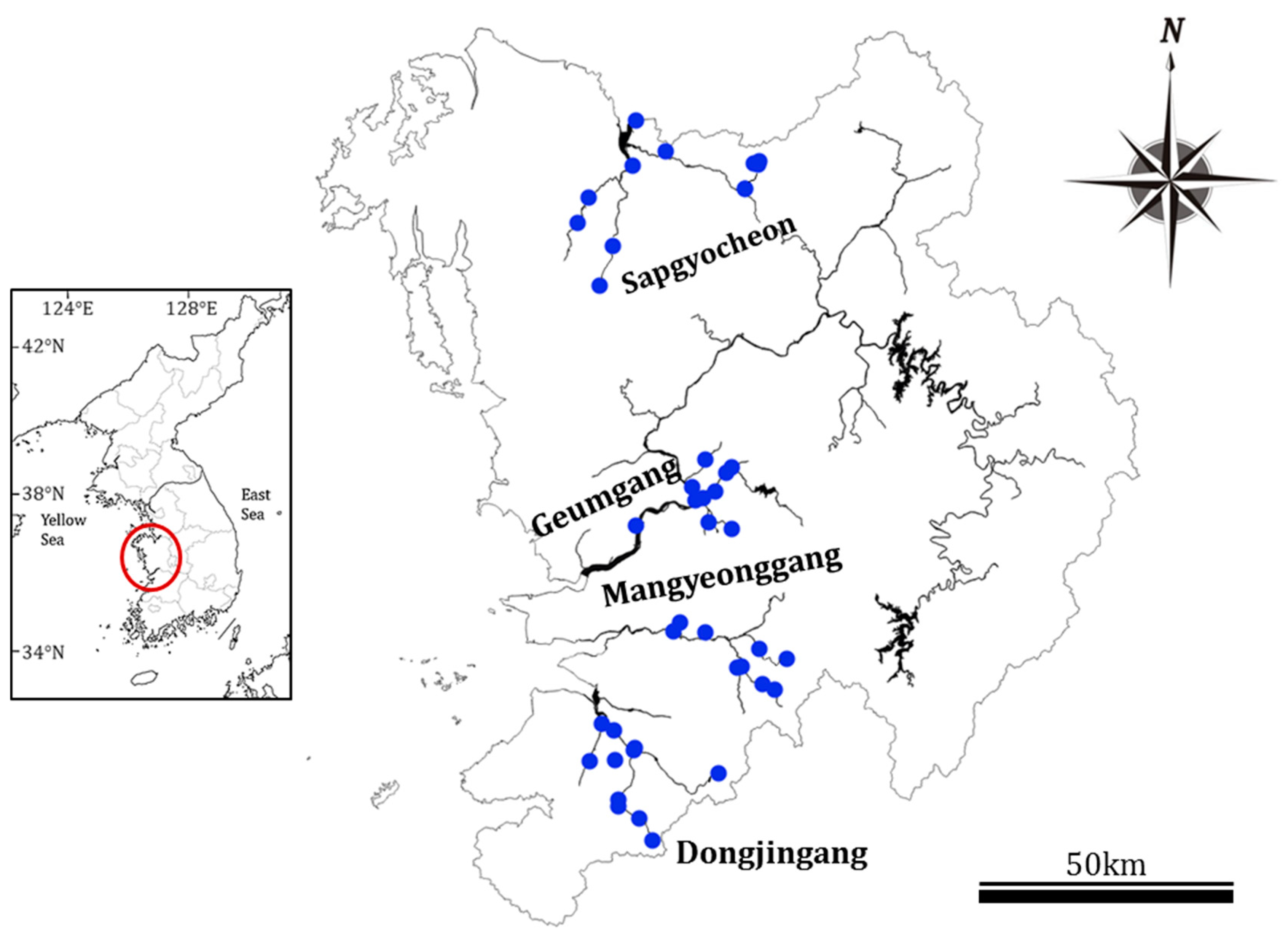
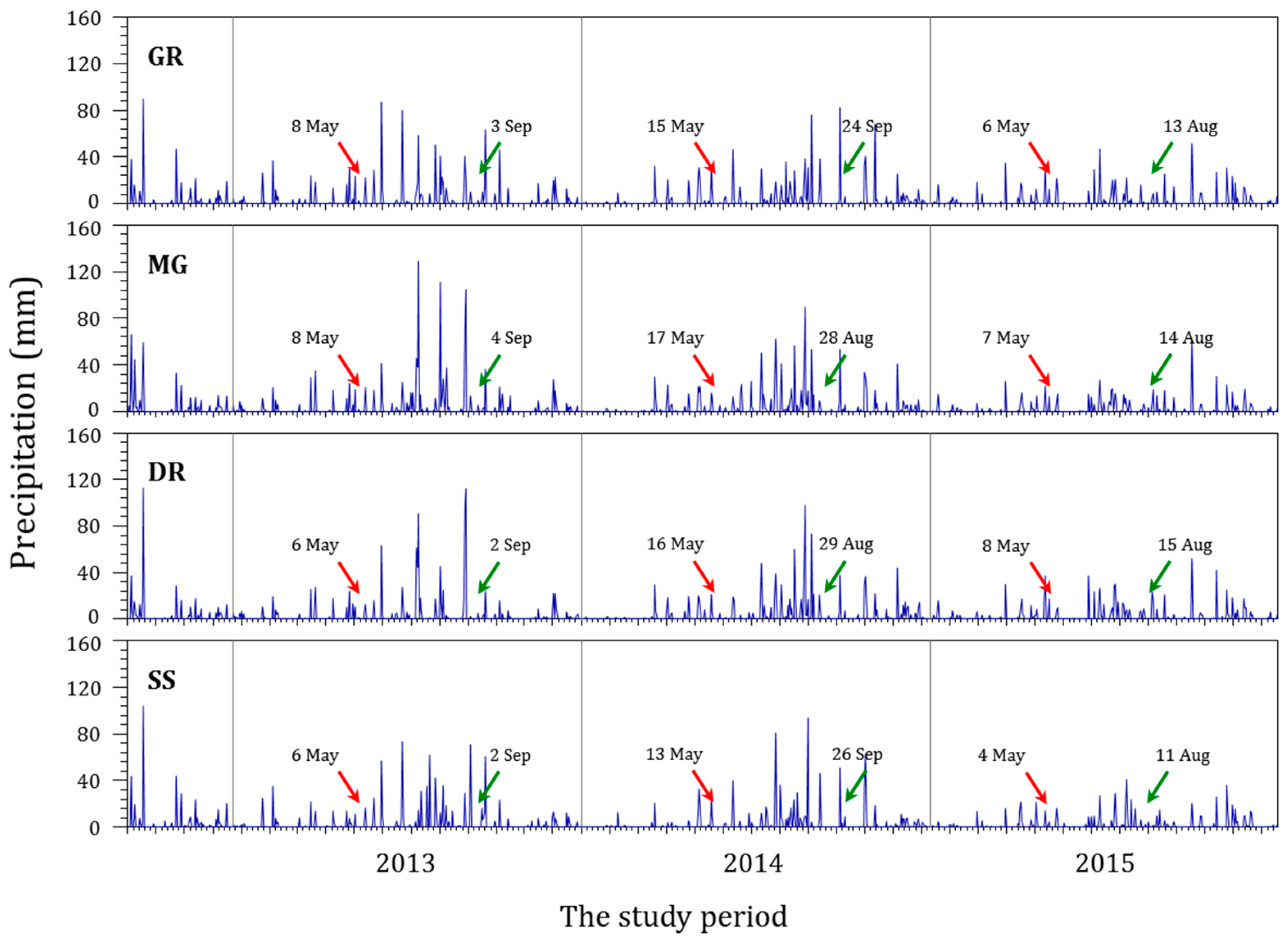


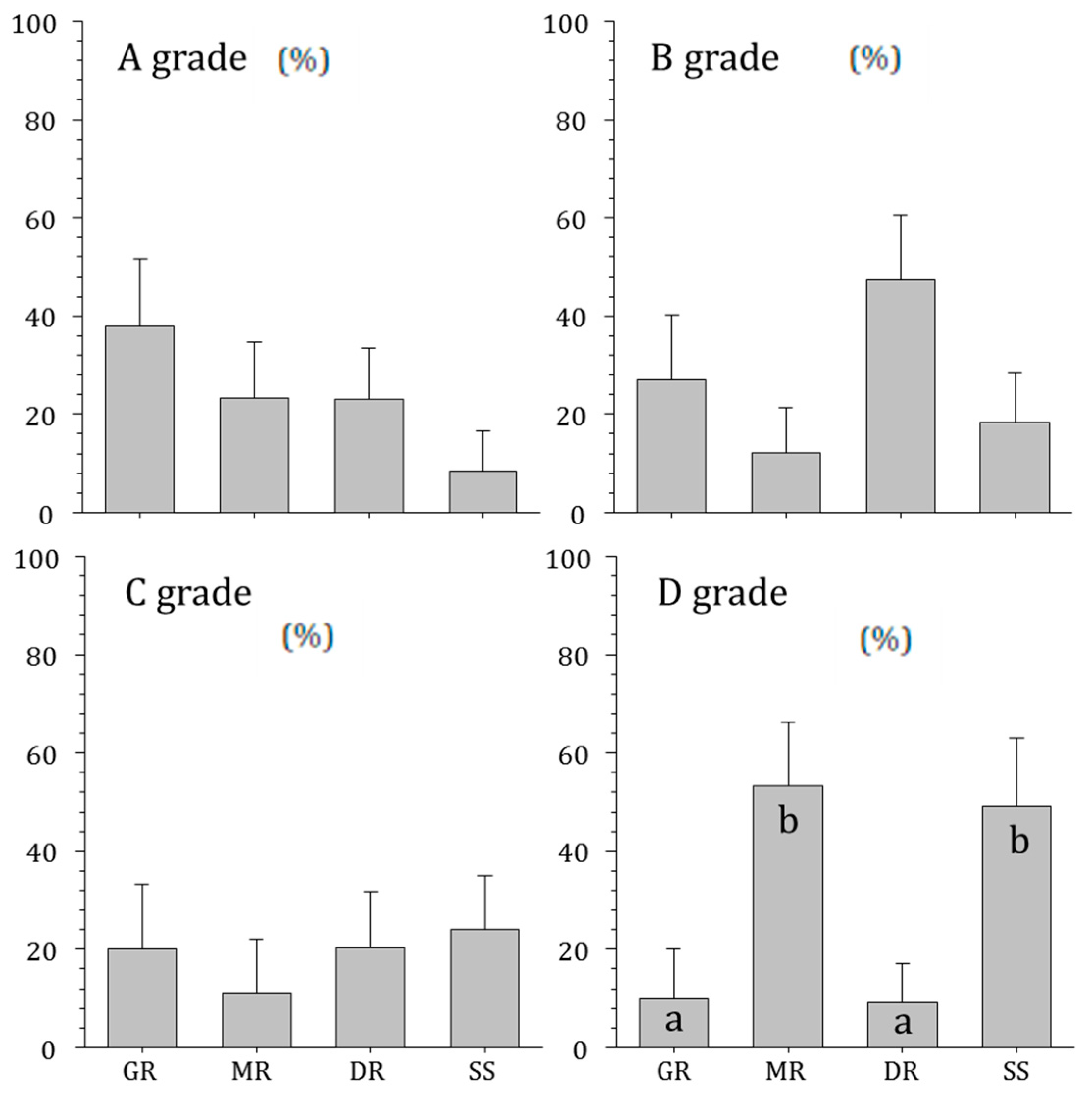
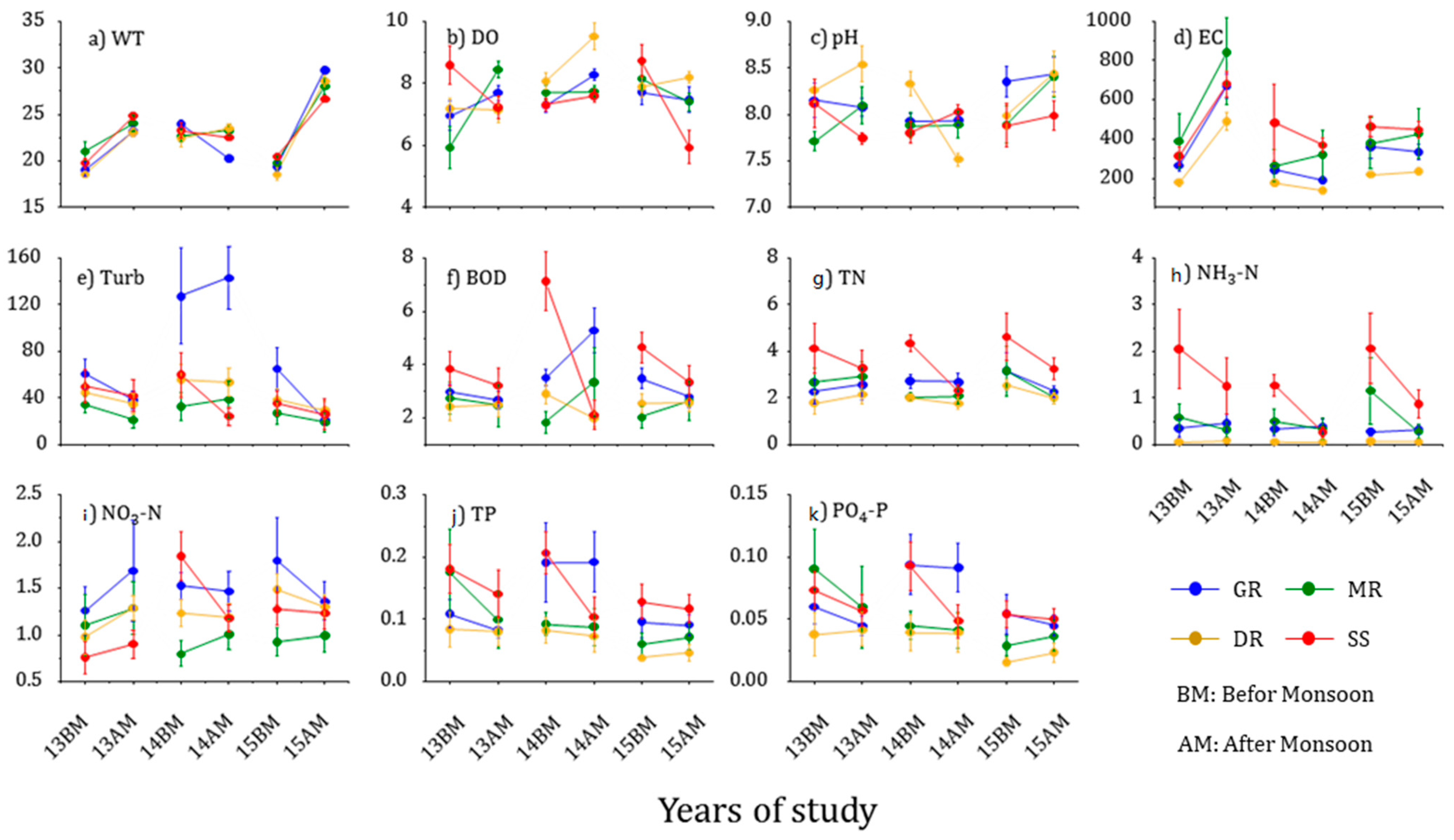
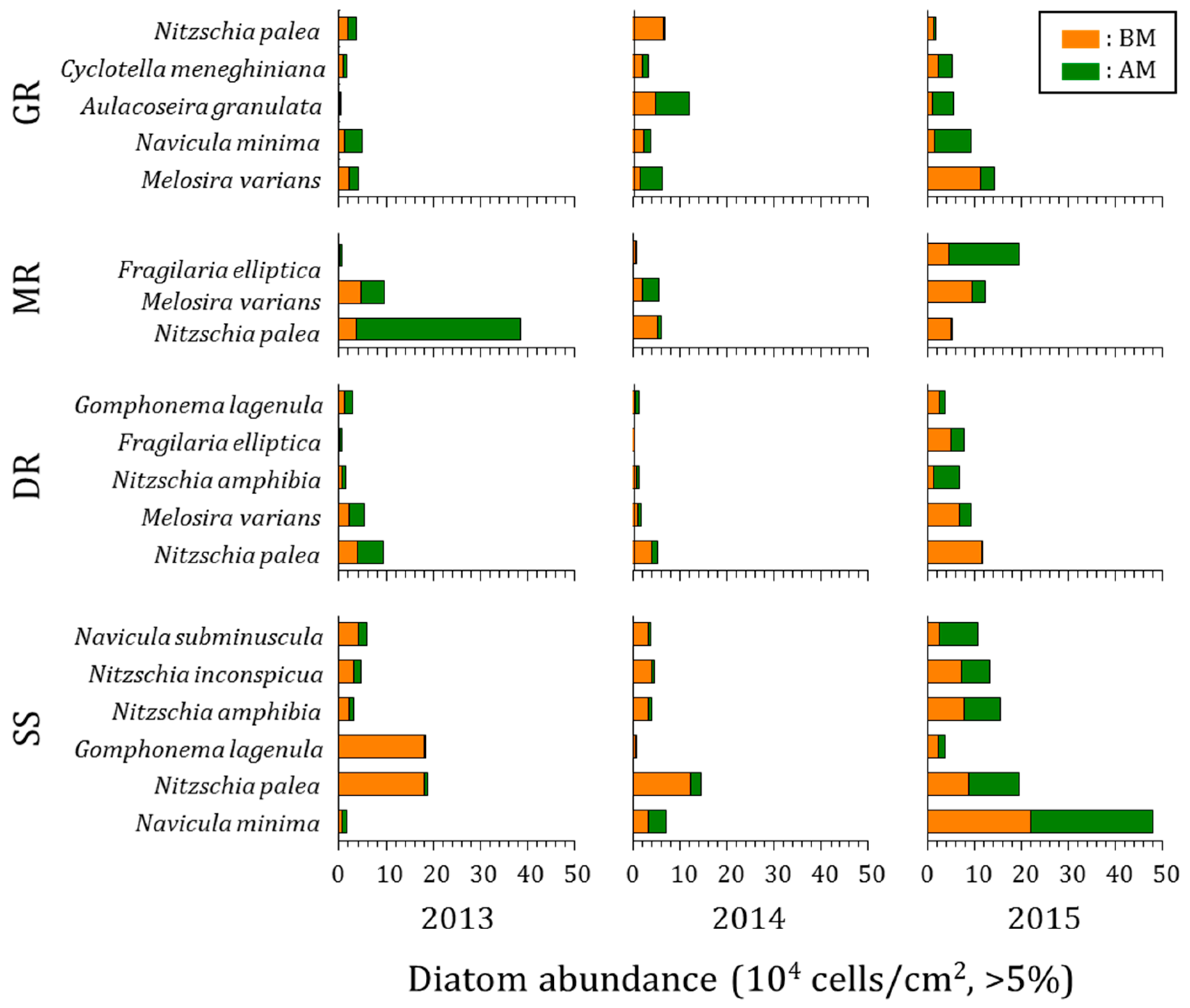
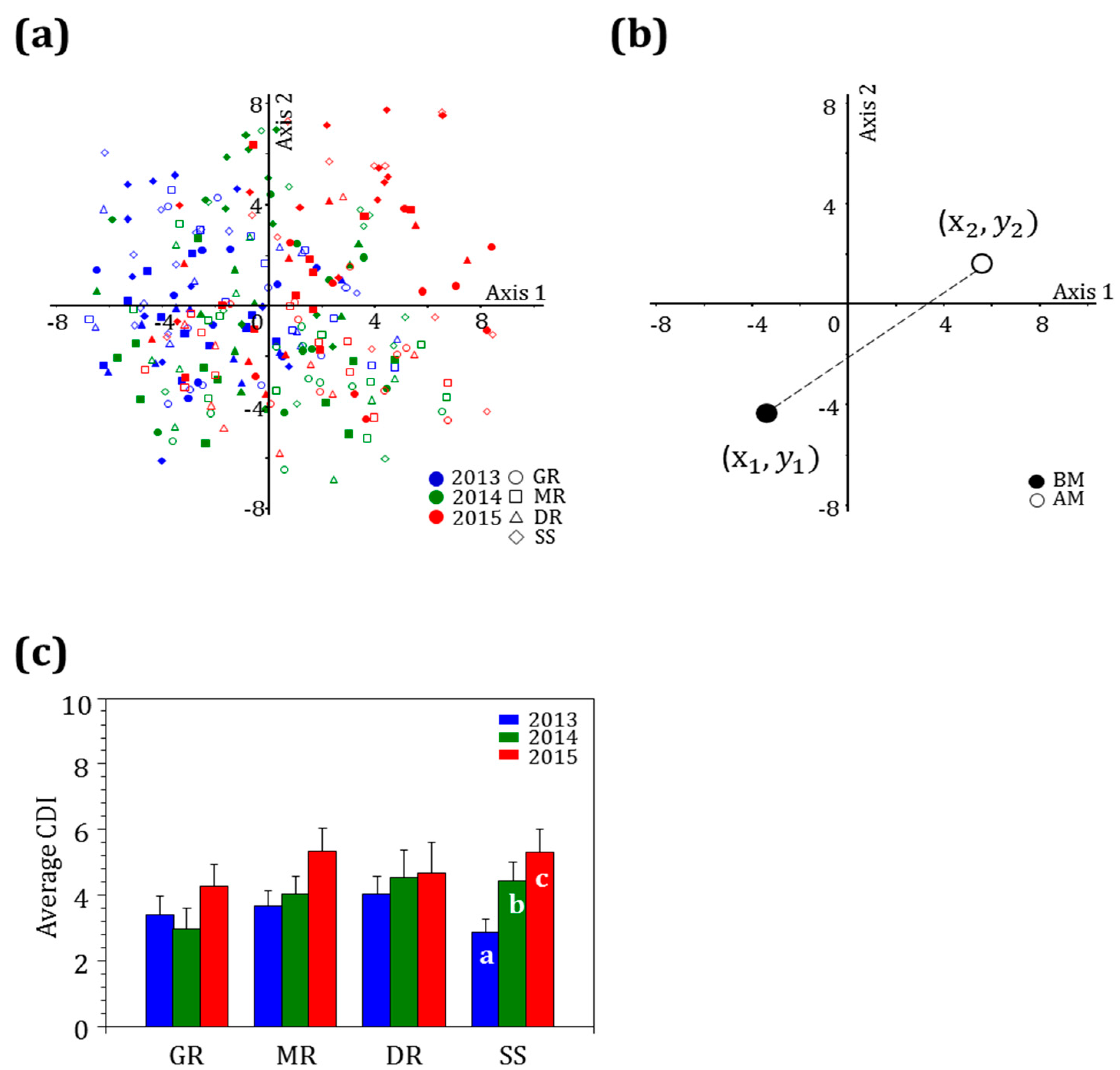
| Characters | Characteristics of Soil | |||
|---|---|---|---|---|
| Drainage Class | Very Good | Good | Bad | Very Bad |
| Permeability (cm/h) | Very fast (>12.0) | Fast (12.0–6.0) | Slow (6.0–5.0) | Very slow (<0.5) |
| Hydrological soil group (grade) | A | B | C | D |
| Sites | Sum of Precipitation for a Certain Period before the Second Sampling (mm) | Precipitation Frequency in Monsoon Period (No.) | |||||||||
|---|---|---|---|---|---|---|---|---|---|---|---|
| 1 wk | 2 wk | 3 wk | 4 wk | Total | ≥10 mm | ≥30 mm | ≥50 mm | ≥70 mm | ≥90 mm | ||
| GR | 2013 | 10.0 | 81.9 | 81.9 | 86.6 | 631.5 | 17.0 | 6.0 | 4.0 | 2.0 | 0.0 |
| 2014 | 77.0 | 77.0 | 81.1 | 127.6 | 622.0 | 15.9 | 6.9 | 1.9 | 1.9 | 0.0 | |
| 2015 | 17.6 | 17.6 | 46.5 | 63.7 | 273.3 | 10.0 | 1.0 | 0.0 | 0.0 | 0.0 | |
| MR | 2013 | 14.6 | 191.4 | 194.5 | 194.5 | 853.3 | 18.2 | 8.0 | 4.0 | 3.0 | 3.0 |
| 2014 | 33.7 | 89.6 | 103.6 | 154.3 | 752.4 | 22.1 | 7.1 | 5.1 | 1.0 | 0.0 | |
| 2015 | 11.7 | 11.7 | 25.4 | 64.0 | 270.5 | 10.0 | 0.0 | 0.0 | 0.0 | 0.0 | |
| DR | 2013 | 0.3 | 208.5 | 228.5 | 228.5 | 726.0 | 15.3 | 7.1 | 4.9 | 3.0 | 3.0 |
| 2014 | 97.9 | 264.2 | 302.4 | 398.7 | 667.6 | 19.3 | 6.1 | 3.2 | 1.9 | 0.9 | |
| 2015 | 18.7 | 26.2 | 39.1 | 77.0 | 326.6 | 11.0 | 2.0 | 0.0 | 0.0 | 0.0 | |
| SS | 2013 | 70.7 | 100.1 | 103.1 | 121.8 | 622.6 | 15.9 | 7.9 | 4.1 | 2.1 | 0.3 |
| 2014 | 55.5 | 55.5 | 55.5 | 109.5 | 913.2 | 13.0 | 6.0 | 3.0 | 2.0 | 1.0 | |
| 2015 | 6.5 | 46.5 | 115.6 | 120.6 | 272.1 | 9.2 | 1.1 | 0.0 | 0.0 | 0.0 | |
| Variables | GR | MG | DG | SS | F | p | |
|---|---|---|---|---|---|---|---|
| WT | BM | 20.8 ± 0.5 | 21.2 ± 0.5 | 19.9 ± 0.5 | 21.2 ± 0.4 | 1.697 | 0.171 |
| AM | 24.4 ± 0.8 ** | 25.1 ± 0.6 ** | 25.1 ± 0.5 ** | 24.7 ± 0.4 ** | 0.351 | 0.788 | |
| DO | BM | 7.3 ± 0.2 a | 7.3 ± 0.3 a | 7.7 ± 0.2 a,b | 8.2 ± 0.3 b | 2.916 | 0.037 |
| AM | 7.8 ± 0.2 b | 7.9 ± 0.2 b | 8.3 ± 0.3 b | 6.9 ± 0.3 a(**) | 6.880 | <0.001 | |
| BOD | BM | 3.3 ± 0.2 b | 2.2 ± 0.3 a | 2.6 ± 0.2 a,b | 5.2 ± 0.5 c | 15.037 | <0.001 |
| AM | 3.6 ± 0.4 | 2.8 ± 0.5 | 2.4 ± 0.2 | 2.9 ± 0.4 (**) | 1.796 | 0.152 | |
| pH | BM | 8.1 ± 0.1 b | 7.8 ± 0.1 a | 8.2 ± 0.1 b | 7.9 ± 0.1 a | 2.899 | 0.038 |
| AM | 8.1 ± 0.1 | 8.1 ± 0.1 * | 8.2 ± 0.1 | 7.9 ± 0.1 | 1.497 | 0.219 | |
| EC | BM | 287.9 ± 23.1 a,b | 342.4 ± 67.6 b | 191.3 ± 10.1 a | 420.1 ± 67.2 b | 4.058 | 0.009 |
| AM | 397.0 ± 44.1 a,b,* | 530.0 ± 112.6 b | 288.2 ± 30.7 a,** | 498.7 ± 35.7 b | 3.499 | 0.018 | |
| Turb | BM | 84.2 ± 16.0 b | 31.2 ± 5.4 a | 46.4 ± 6.0 a | 48.5 ± 8.6 a | 4.787 | 0.003 |
| AM | 67.5 ± 13.6 b | 26.5 ± 6.4 a | 39.2 ± 5.7 a | 30.7 ± 6.7 a | 4.441 | 0.005 | |
| TN | BM | 2.72 ± 0.33 a | 2.63 ± 0.4 a | 2.12 ± 0.19 a | 4.37 ± 0.49 b | 7.323 | <0.001 |
| AM | 2.51 ± 0.26 | 2.35 ± 0.26 | 1.97 ± 0.17 | 2.95 ± 0.31 (*) | 2.670 | 0.051 | |
| NH3-N | BM | 0.32 ± 0.08 a | 0.75 ± 0.26 a | 0.06 ± 0.01 a | 1.79 ± 0.38 b | 10.193 | <0.001 |
| AM | 0.39 ± 0.09 a,b | 0.31 ± 0.10 a | 0.07 ± 0.01 a | 0.80 ± 0.23 b(*) | 4.700 | 0.004 | |
| NO3-N | BM | 1.53 ± 0.18 b | 0.94 ± 0.13 a | 1.23 ± 0.1 a,b | 1.29 ± 0.14 a,b | 2.689 | 0.049 |
| AM | 1.51 ± 0.20 | 1.10 ± 0.12 | 1.26 ± 0.08 | 1.10 ± 0.09 | 2.196 | 0.092 | |
| TP | BM | 0.13 ± 0.02 b,c | 0.11 ± 0.03 a,b | 0.07 ± 0.01 a | 0.17 ± 0.02 c | 4.798 | 0.003 |
| AM | 0.12 ± 0.02 | 0.09 ± 0.02 | 0.07 ± 0.01 | 0.12 ± 0.02 | 2.563 | 0.058 | |
| PO4-P | BM | 0.07 ± 0.01 b | 0.05 ± 0.01 a,b | 0.03 ± 0.01 a | 0.07 ± 0.01 b | 4.076 | 0.008 |
| AM | 0.06 ± 0.01 | 0.05 ± 0.01 | 0.03 ± 0.01 | 0.05 ± 0.01 | 1.628 | 0.186 | |
| Variables | Sum of Precipitation (mm) | Precipitation Frequency in Monsoon Period (No.) | |||||||||
|---|---|---|---|---|---|---|---|---|---|---|---|
| 1 wk | 2 wk | 3 wk | 4 wk | Total | ≥10 mm | ≥30 mm | ≥50 mm | ≥70 mm | ≥90 mm | ||
| WT | GR | −0.756 ** | −0.515 ** | −0.636 ** | −0.878 ** | −0.659 ** | −0.573 ** | −0.712 ** | −0.382 * | −0.624 ** | − |
| MR | − | − | − | − | −0.539 ** | −0.610 ** | −0.557 ** | −0.592 ** | − | − | |
| DR | −0.393 * | −0.703 ** | −0.713 ** | −0.786 ** | −0.610 ** | −0.780 ** | −0.586 ** | −0.536 ** | −0.551 ** | − | |
| SS | −0.384 * | − | 0.760 ** | 0.748 ** | −0.432 ** | −0.340 * | −0.357 * | −0.432 ** | −0.614 ** | ||
| DO | GR | − | − | − | − | − | − | 0.376* | − | − | − |
| MR | − | 0.509 ** | 0.485 * | 0.394 * | 0.519 ** | − | 0.491 ** | 0.421 * | 0.645 ** | 0.643 ** | |
| DR | − | − | − | − | − | − | − | − | − | − | |
| SS | 0.495 ** | − | −0.580 ** | −0.516 ** | 0.522 ** | 0.375 * | 0.474 ** | 0.484 ** | 0.531 ** | 0.537 ** | |
| pH | GR | − | − | − | − | − | − | − | − | − | − |
| MR | − | − | − | − | − | − | − | − | − | − | |
| DR | −0.557 ** | −0.560 ** | −0.579 ** | −0.684 ** | −0.442 * | −0.717 ** | −0.424 * | −0.364 * | −0.358 * | − | |
| SS | − | − | − | − | − | − | − | − | − | − | |
| EC | GR | −0.769 ** | − | − | −0.516 ** | − | − | − | − | − | − |
| MR | − | 0.438 * | 0.424 * | − | − | − | − | − | 0.494 ** | 0.521 ** | |
| DR | −0.820 ** | − | − | − | − | − | − | − | − | 0.475 ** | |
| SS | − | 0.483 ** | − | − | 0.295 | 0.420 * | 0.352 * | 0.337 * | − | − | |
| TP | GR | − | − | − | − | − | − | − | − | − | − |
| MR | − | −0.445 * | −0.435 * | −0.385 * | − | − | − | − | −0.436* | −0.455* | |
| DR | − | − | − | − | − | − | − | − | − | − | |
| SS | − | − | 0.425 ** | 0.395 * | − | − | − | − | −0.332 * | −0.391 * | |
| PO4-P | GR | − | − | − | − | − | − | − | − | − | − |
| MR | − | − | − | − | − | − | − | − | −0.385 * | − | |
| DR | − | − | − | − | − | − | − | − | − | − | |
| SS | − | − | 0.389 * | 0.362 * | − | − | − | − | − | −0.333 * | |
| Species | 2013 | 2014 | 2015 | p | ||
|---|---|---|---|---|---|---|
| GR | BM | Navicula capitatoradiata | 61 | 1 | 4 | 0.003 |
| Achnanthes hungarica | 58 | 1 | 1 | 0.002 | ||
| Navicula contenta | 42 | 2 | 0 | 0.008 | ||
| Aulacoseira ambigua | 40 | 0 | 0 | 0.016 | ||
| Cocconeis placentula var. lineata | 40 | 0 | 0 | 0.022 | ||
| Navicula veneta | 0 | 40 | 0 | 0.020 | ||
| Cyclotella stelligera | 0 | 0 | 70 | 0.001 | ||
| Navicula cryptotenella | 0 | 0 | 70 | 0.001 | ||
| Gomphonema lagenula | 7 | 0 | 69 | 0.001 | ||
| Fragilaria delicatissima | 0 | 5 | 45 | 0.004 | ||
| AM | Gomphonema parvulum | 53 | 1 | 0 | 0.001 | |
| Aulacoseira ambigua | 50 | 0 | 0 | 0.008 | ||
| Navicula veneta | 0 | 72 | 1 | 0.001 | ||
| Navicula amphiceropsis | 0 | 60 | 0 | 0.001 | ||
| Nitzschia levidensis | 0 | 40 | 0 | 0.027 | ||
| Aulacoseira granulata var. angustissima | 0 | 0 | 40 | 0.024 | ||
| Navicula schroeteri | 4 | 1 | 34 | 0.021 | ||
| MR | BM | Fragilaria bidens 8 | 48 | 21 | 0 | 0.009 |
| Gomphonema pseudoaugur | 40 | 0 | 6 | 0.032 | ||
| Ulnaria ulna | 10 | 14 | 53 | 0.007 | ||
| Navicula viridula var. rostellata | 1 | 43 | 5 | 0.037 | ||
| Navicula trivialis | 2 | 38 | 2 | 0.044 | ||
| Fragilaria capucina | 0 | 1 | 81 | 0.001 | ||
| Cyclotella stelligera | 0 | 0 | 44 | 0.013 | ||
| Surirella angusta | 0 | 0 | 44 | 0.021 | ||
| AM | Cymbella affinis | 48 | 12 | 2 | 0.021 | |
| Nitzschia inconspicua | 45 | 14 | 10 | 0.031 | ||
| Navicula notha | 44 | 0 | 0 | 0.027 | ||
| Cocconeis placentula var. lineata | 0 | 56 | 0 | 0.009 | ||
| Navicula gregaria | 2 | 48 | 0 | 0.007 | ||
| Navicula amphiceropsis | 0 | 48 | 2 | 0.011 | ||
| Cymbella cistula | 2 | 43 | 0 | 0.014 | ||
| Aulacoseira granulata | 0 | 36 | 2 | 0.030 | ||
| Cymbella leptoceros | 0 | 0 | 44 | 0.026 | ||
| Navicula decussis | 0 | 0 | 44 | 0.025 | ||
| DR | BM | Cocconeis placentula var. lineata | 64 | 0 | 0 | 0.002 |
| Aulacoseira ambigua | 55 | 0 | 0 | 0.003 | ||
| Cyclotella pseudostelligera | 55 | 0 | 0 | 0.003 | ||
| Gomphonema angustatum | 55 | 0 | 0 | 0.003 | ||
| Navicula gregaria | 50 | 2 | 10 | 0.006 | ||
| Nitzschia frustulum | 36 | 0 | 0 | 0.024 | ||
| Nitzschia gracilis | 36 | 0 | 0 | 0.030 | ||
| Nitzschia subacicularis | 36 | 0 | 0 | 0.028 | ||
| Gomphonema parvulum | 1 | 75 | 1 | 0.001 | ||
| Fragilaria bidens | 4 | 65 | 0 | 0.002 | ||
| Cyclotella stelligera | 0 | 63 | 3 | 0.001 | ||
| Aulacoseira granulata | 1 | 52 | 1 | 0.005 | ||
| Achnanthes delicatula | 0 | 36 | 2 | 0.022 | ||
| Gomphonema clevei | 1 | 33 | 1 | 0.038 | ||
| Cyclotella atomus | 0 | 0 | 45 | 0.008 | ||
| AM | Navicula recens | 55 | 0 | 0 | 0.002 | |
| Navicula notha | 38 | 1 | 0 | 0.015 | ||
| Aulacoseira ambigua | 36 | 0 | 0 | 0.026 | ||
| Cyclotella atomus | 36 | 0 | 0 | 0.035 | ||
| Ulnaria acus (Kützing) Aboal | 36 | 0 | 0 | 0.024 | ||
| Cymbella cistula | 26 | 5 | 0 | 0.046 | ||
| Fragilaria delicatissima | 0 | 45 | 0 | 0.003 | ||
| SS | BM | Navicula cari | 50 | 1 | 0 | 0.002 |
| Fragilaria bidens | 46 | 3 | 0 | 0.001 | ||
| Navicula cryptocephala | 2 | 48 | 8 | 0.005 | ||
| Fragilaria elliptica | 1 | 1 | 61 | 0.001 | ||
| Navicula veneta | 0 | 4 | 39 | 0.005 | ||
| AM | Navicula seminulum | 58 | 0 | 0 | 0.001 | |
| Nitzschia subacicularis | 36 | 1 | 0 | 0.005 | ||
| Nitzschia paleacea | 0 | 0 | 42 | 0.011 | ||
| Cyclotella stelligera | 0 | 5 | 24 | 0.046 |
| Sum of Precipitation (mm) | GR | MR | DR | SS | Precipitation Intensity and Frequency (No.) | GR | MR | DR | SS |
|---|---|---|---|---|---|---|---|---|---|
| 1 wk | −0.226 | −0.101 | 0.039 | −0.377 * | ≥10 mm | −0.242 | −0.358 | 0.012 | −0.450 ** |
| 2 wk | −0.282 | −0.265 | −0.015 | −0.480 ** | ≥30 mm | −0.266 | −0.409 * | −0.066 | −0.425 ** |
| 3 wk | −0.312 | −0.234 | −0.033 | −0.047 | ≥50 mm | −0.159 | −0.382 * | −0.082 | −0.411 * |
| 4 wk | −0.335 | −0.173 | −0.002 | −0.153 | ≥70 mm | −0.224 | −0.351 | −0.112 | −0.350 * |
| Total | −0.301 | −0.385 * | −0.026 | −0.353 * | ≥90 mm | 0 | −0.265 | −0.123 | 0.026 |
Disclaimer/Publisher’s Note: The statements, opinions and data contained in all publications are solely those of the individual author(s) and contributor(s) and not of MDPI and/or the editor(s). MDPI and/or the editor(s) disclaim responsibility for any injury to people or property resulting from any ideas, methods, instructions or products referred to in the content. |
© 2023 by the authors. Licensee MDPI, Basel, Switzerland. This article is an open access article distributed under the terms and conditions of the Creative Commons Attribution (CC BY) license (https://creativecommons.org/licenses/by/4.0/).
Share and Cite
Hwang, E.-A.; Cho, I.-H.; Kim, H.-K.; Yi, C.; Kim, B.-H. The Relationship between Rainfall Pattern and Epilithic Diatoms in Four Streams of Central-Western Korea for Three Years (2013–2015). Int. J. Environ. Res. Public Health 2023, 20, 4099. https://doi.org/10.3390/ijerph20054099
Hwang E-A, Cho I-H, Kim H-K, Yi C, Kim B-H. The Relationship between Rainfall Pattern and Epilithic Diatoms in Four Streams of Central-Western Korea for Three Years (2013–2015). International Journal of Environmental Research and Public Health. 2023; 20(5):4099. https://doi.org/10.3390/ijerph20054099
Chicago/Turabian StyleHwang, Eun-A, In-Hwan Cho, Ha-Kyung Kim, Chen Yi, and Baik-Ho Kim. 2023. "The Relationship between Rainfall Pattern and Epilithic Diatoms in Four Streams of Central-Western Korea for Three Years (2013–2015)" International Journal of Environmental Research and Public Health 20, no. 5: 4099. https://doi.org/10.3390/ijerph20054099
APA StyleHwang, E.-A., Cho, I.-H., Kim, H.-K., Yi, C., & Kim, B.-H. (2023). The Relationship between Rainfall Pattern and Epilithic Diatoms in Four Streams of Central-Western Korea for Three Years (2013–2015). International Journal of Environmental Research and Public Health, 20(5), 4099. https://doi.org/10.3390/ijerph20054099








